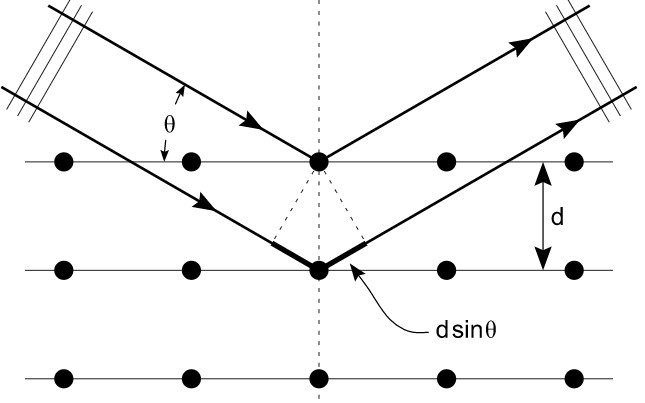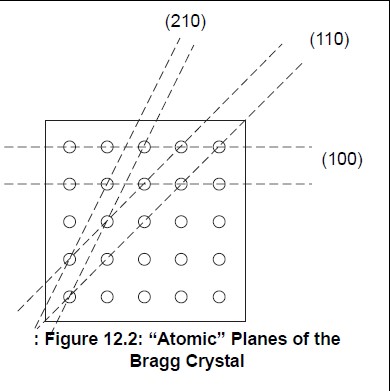Microwave Diffraction
Introduction
This experiment uses microwaves to explore reflection, interference, and then an interesting sort of combination of the two: diffraction.
2.1 Reflection
When electromagnetic radiation, such as microwaves or visible light, hits a reflective surface, such as a metal plate or a mirror, then the wave is said to reflect ‘specularly’. That is to say, the angle of incidence (![]() ) is equal to the angle of reflection(
) is equal to the angle of reflection(![]() ), as in Figure 1(a). The opposite of specular reflection is ‘diffuse’ reflection, where the angle of reflection can be a value(s) other than the angle of incidence.
), as in Figure 1(a). The opposite of specular reflection is ‘diffuse’ reflection, where the angle of reflection can be a value(s) other than the angle of incidence.
Figure 1: Examples of (a) specular and (b) diffuse reflection.
Note that this behaviour assumes that the reflecting surface is flat compared to the wavelength of the electromagnetic radiation. When there are features on the scale of the wavelength, then the physics becomes much more interesting.
Interference
The double-slit experiment is a pretty famous experiment that demonstrates the wave nature of light. Two slits are cut into the reflector a distance ![]() apart. The incident plane wave will diffract through the slits and create a pattern of constructive and destructive interference, as shown in Figure 2. The maxima of the interference pattern follow a surprisingly simple equation:
apart. The incident plane wave will diffract through the slits and create a pattern of constructive and destructive interference, as shown in Figure 2. The maxima of the interference pattern follow a surprisingly simple equation:
(1) ![]()
where ![]() is the angle relative to the normal plane,
is the angle relative to the normal plane, ![]() is the wavelength of light, and
is the wavelength of light, and ![]() is some integer.
is some integer.
Figure 2: An example of the constructive and destructive interference due to a plane-wave diffracting through two slits. Green represents zero amplitude and red maximum amplitude.
2.3 Bragg Diffraction
The final type of wave behaviour explored in this experiment is diffraction; specifically Bragg diffraction. Bragg diffraction occurs when electromagnetic radiation is incident on a plane made of a pattern of scattering sites, as in Figure 3.
A derivation of the Bragg condition can be found here. Basically, the spacing between the two scattering planes, accounting for the angle of incidence, is a half-integer of the wavelength:
(2) ![]()
When the Bragg condition is met, the reflection of electromagnetic radiation constructively interferes and is almost specular: A sharp increase in signal would be measured where the angle of reflection equals the angle of incidence. When the Bragg condition is not met, the reflected radiation destructively interferes, and no significant signal is measured when ![]() .
.
Figure 3: Electromagnetic radiation incident on a plane of periodic scattering points. When the extra distance traversed by the lower beam is equal to an integer number of wavelengths, then the Bragg condition is met and the wave reflects almost specularly from the lattice. Figure from Wikipedia.
Figure 4: A simple cubic lattice with the atomic planes defined using Miller indices. Figure from TeachSpin manual.
There are many different lattice structures found in nature, but for this experiment we will start with a simple cubic crystal, as shown in Figure 4. You can see the atomic planes of the crystal defined using the Miller indices. Take a look at the designations in Figure 4 and see if you can determine why the atomic planes are labelled as they are.
2.4 Neutron Diffraction
Wave phenomenon is not restricted to only waves! DeBroglie (for his PhD these, no less) postulated that matter with linear momentum can be treated as a wave:
(3) ![]()
where ![]() is Planck’s constant and
is Planck’s constant and ![]() is the momentum of the matter. A neutron beam, like the one used at the McMaster Nuclear Reactor, will have a wavelength on the scale of nanometers. Neutron diffraction can be used to study the lattice structure of exotic magnets and high-temperature super conductors.
is the momentum of the matter. A neutron beam, like the one used at the McMaster Nuclear Reactor, will have a wavelength on the scale of nanometers. Neutron diffraction can be used to study the lattice structure of exotic magnets and high-temperature super conductors.
If you are interested in doing more experiments in condensed matter, then get in touch with Dr. FitzGreen. It is likely possible that you could do some neutron scattering experiments with Dr. Pat Clancy using the neutron beam from the McMaster Nuclear Reactor.


